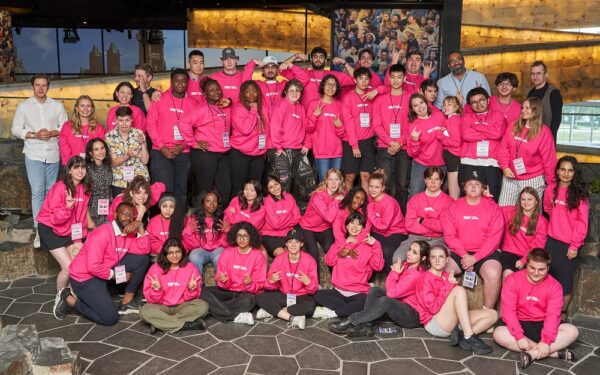Imagine trying to navigate the vast world of the internet without being able to see it. How can you understand the concept of something “living forever” on the internet if you don’t know what that looks like? How can you meaningfully participate online independently and safely when the internet isn’t accessible? These were questions that the team at the Canadian National Institute for the Blind (CNIB) wanted to address with their CIRA Net Good Grant.
CNIB is a non-profit organization dedicated to delivering innovative programs and advocacy initiatives that empower people impacted by blindness. I recently had the opportunity to speak with Daniel Moore, Director, Corporate and Foundation Partnerships; Becky Dyck, Program Lead, Children & Youth; and Kathy Beitz, lead knowledge translation, to learn more about the impact of this project and CIRA’s support.
The inspiration for the project came from a participant in CNIB’s youth programming who highlighted a critical gap in digital skills training. The young person pointed out that disclosing a disability online can lead to challenges in employment, safety and social inclusion—like being a target for scams or experiencing discrimination when applying for jobs. CNIB’s National Youth Council was consulted about whether they felt more guidance accessing online spaces was needed, and the answer was a unanimous “yes.”

Enter Safe Internet Use with Sight Loss (SIUSS), a free, first of its kind, scalable curriculum designed to teach young Canadians with sight loss how to safely access and participate in the online world. As children are introduced to the internet at increasingly younger ages for school, entertainment and social interaction, skills such as managing digital footprints, practicing digital citizenship and fostering healthy online relationships are crucial. However, the internet is predominantly designed for the sighted, and existing online safety programs for youth often overlook the unique needs of those with sight loss or blindness. “There was a gap around safe internet use with a disability lens for youth specifically,” said Daniel.
In their research, the CNIB team identified four main gaps in online safety education for youth experiencing sight loss and blindness that formed the basis of the SIUSS curriculum: advocacy (learning about one’s needs, when to talk about internet issues and who to talk to), accessibility (what internet accessibility is, how to learn if a site is accessible and solutions for accessibility), assistive technology (vocabulary, awareness and practice of using and navigating assistive technology online) and consent and disclosure (learning and applying one’s rights when using the internet).
The goal was to instill a sense of ownership and digital citizenship in children, promoting responsibility in their internet use. As Daniel pointed out, “It gives them a sense of independence when their world is very controlled for them.”
Delivered in booklet form online and in Braille, the pilot of the SIUSS curriculum has already reached 58 children in grades K-12 with the first run of interactive workshops. Topics include understanding internet vocabulary, practicing online self-advocacy, exploring accessibility features and identifying online misinformation. Becky noted that while the participants were already internet-savvy, there were still significant knowledge gaps. “A kid may know what accessibility is, but they were never taught how to apply it to their lives necessarily,” she said.

The curriculum features engaging activities and games based on real-life scenarios so that participants can learn through play. One activity has them roleplaying YouTube hosts or social media influencers to explore accessibility features in online and gaming platforms; in another activity, they are encouraged to stop and think about making positive choices about what they post online by creating a digital time capsule of their online presence. In the game Is This the Real Deal participants use traffic light signals to decide how to react to scenarios involving misinformation or suspicious websites.
The casual format of the workshops has encouraged lively discussions among the participants about their own online experiences and problem-solving strategies. A survey revealed that most participants have taken away valuable new concepts from the workshops. “The problem-solving skills from the games can be used not just in childhood, but going forward in employment and education,” Daniel said.
The curriculum’s success, and its scalable nature, has led to wide adoption throughout CNIB’s programming: Children & Youth Program Leads across the country; their summer camp for people with sight loss, CNIB Lake Joe; their national Learning Academy program; and the CNIB Come to Work employment program that helps people learn to use accessible technology and achieve success in the workforce.
Now youth experiencing sight loss and blindness are facing a new challenge that CNIB is keen to address: artificial intelligence (AI). “AI can seem real for people with sight loss—they can’t see the red flags,” Becky explained. “We don’t have control over that quite yet. We need to make children aware of it.” As technology evolves, CNIB is committed to adapting SIUSS to address these new risks, ensuring the next generation has the tools to navigate the online world safely and mindfully.
CIRA awards over a million dollars of funding annually to infrastructure, online safety and policy engagement initiatives that are working to make the internet better for Canadians. Read about our 2024 recipients.
Caitlin is part of CIRA’s Net Good team as Grants Coordinator. Her background is in the charitable sector, and she is passionate about funding digital equity.





